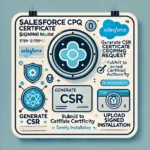Escalation Rule in Salesforce-In Salesforce, managing customer support and service requests efficiently is critical to maintaining high levels of customer satisfaction. One of the key features that facilitate this is the Escalation Rule. Escalation rules help ensure that cases are addressed in a timely manner and meet the required service levels. This comprehensive guide will cover what escalation rules are, how they work, their benefits, and provide a detailed look at their configuration, including common use cases and FAQs.
What Are Escalation Rules?
Escalation rules in Salesforce are designed to automatically escalate cases that meet certain criteria. This ensures that high-priority cases or those that have not been addressed within a specified timeframe are promptly handled by a more senior or specialized team member. Escalation rules help manage cases more effectively and improve the overall efficiency of customer support operations.
Key Components of Escalation Rules
- Rule Criteria: Defines the conditions under which a case should be escalated. This could be based on case age, priority, or other custom criteria.
- Escalation Actions: Specifies what should happen when a case meets the rule criteria. This could include changing the case owner, updating the case status, or sending notifications.
- Escalation Timeframes: Determines the timing for escalation, such as how long a case must remain in a certain status before being escalated.
Benefits of Escalation Rules
- Improved Response Times: Ensures that cases are addressed promptly, reducing the risk of cases being overlooked or delayed.
- Enhanced Customer Satisfaction: By managing high-priority cases more effectively, escalation rules help maintain high levels of customer satisfaction.
- Increased Efficiency: Automates the process of escalating cases, freeing up time for support staff to focus on other important tasks.
- Compliance with Service Level Agreements (SLAs): Helps in adhering to SLAs by ensuring cases are handled within the agreed-upon timeframes.
How to Configure Escalation Rules in Salesforce
Configuring escalation rules in Salesforce involves several steps, including defining rule criteria, setting escalation actions, and specifying timeframes. Here’s a step-by-step guide to setting up escalation rules:
Step 1: Access Escalation Rules
- Navigate to Setup: Click on the gear icon in the upper right corner of Salesforce and select “Setup.”
- Search for Escalation Rules: In the Quick Find box, type “Escalation Rules” and select it from the results.
Step 2: Create a New Escalation Rule
- Click New Rule: Click the “New Rule” button to create a new escalation rule.
- Enter Rule Name: Provide a descriptive name for the rule.
- Select Object: Choose the object for which the escalation rule will apply, typically “Case.”
Step 3: Define Rule Criteria
- Click Rule Criteria: Click the “Rule Criteria” tab to set the conditions for escalation.
- Add Criteria: Define the criteria that must be met for a case to be escalated. This could be based on case fields, such as priority or status.
- Set Evaluation Criteria: Choose how often the rule should be evaluated, such as “Every time a record is created or edited.”
Step 4: Set Escalation Actions
- Click Escalation Actions: Click the “Escalation Actions” tab to define what should happen when a case meets the rule criteria.
- Add Actions: Choose actions such as reassigning the case to a different owner, updating the case status, or sending notifications.
- Specify Timeframes: Define how long the case should wait before the escalation actions are triggered.
Step 5: Activate the Escalation Rule
- Click Save: After configuring the rule, click “Save” to save your changes.
- Activate Rule: Click “Activate” to enable the rule. The rule will now be in effect and will automatically escalate cases based on the defined criteria.
Use Cases for Escalation Rules
Escalation rules can be used in various scenarios to improve case management and ensure timely resolution. Here are some common use cases:
1. High-Priority Case Management
When a case is marked as high priority, it may require immediate attention from a senior support representative. An escalation rule can be set up to automatically assign high-priority cases to a specific team or individual when they are created or updated.
2. Unresolved Cases
If a case remains unresolved for a specified period, it may need to be escalated to ensure it is addressed promptly. An escalation rule can be configured to escalate cases that have not been resolved within the expected timeframe.
3. SLA Compliance
To comply with SLAs, it’s important to address cases within the agreed-upon timeframes. Escalation rules can help by automatically escalating cases that are at risk of breaching SLA deadlines, ensuring they are handled in time.
4. Case Ownership Changes
If a case is not being handled effectively by the current owner, an escalation rule can automatically reassign it to a different support representative or team. This ensures that cases are managed by the appropriate resources.
FAQs
1. What are the main components of an escalation rule in Salesforce?
- The main components include rule criteria (conditions for escalation), escalation actions (what happens when criteria are met), and escalation timeframes (when actions should be triggered).
2. How can I define the criteria for an escalation rule?
- Criteria can be defined based on case fields, such as priority or status, and can be set to evaluate every time a record is created or edited.
3. What types of actions can be set for escalation rules?
- Actions can include reassigning the case to a different owner, updating the case status, sending notifications, or creating tasks for follow-up.
4. How do escalation rules help with SLA compliance?
- By automatically escalating cases that are approaching or breaching SLA deadlines, escalation rules ensure that cases are handled within the required timeframes.
5. Can escalation rules be applied to objects other than cases?
- Yes, while escalation rules are most commonly used for cases, they can be applied to other objects where automatic escalation based on specific criteria is needed.
6. What should be considered when setting up escalation timeframes?
- Consider the urgency of the case, the expected resolution time, and any service level agreements (SLAs) when defining escalation timeframes.
7. How can I test if my escalation rules are working correctly?
- Create test cases that meet the escalation criteria and monitor if the rules trigger the specified actions. Check if the cases are correctly escalated and managed as expected.
8. Can escalation rules be used in conjunction with other Salesforce automation tools?
- Yes, escalation rules can be used alongside other Salesforce automation tools such as workflows, process builder, and triggers to enhance case management and automate processes.
Conclusion
Escalation rules in Salesforce are a powerful feature for managing cases efficiently and ensuring timely resolution. By automating the escalation process based on defined criteria, organizations can improve response times, adhere to service level agreements, and enhance overall customer satisfaction. Implementing and configuring escalation rules effectively can streamline case management, optimize support operations, and ensure that critical issues receive the attention they require.
With a solid understanding of escalation rules, their benefits, and how to configure them, you can leverage this feature to maintain high standards of service and support within your Salesforce environment.


